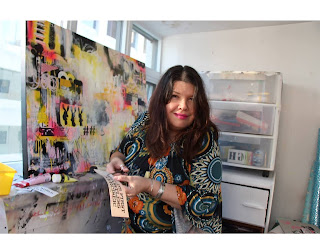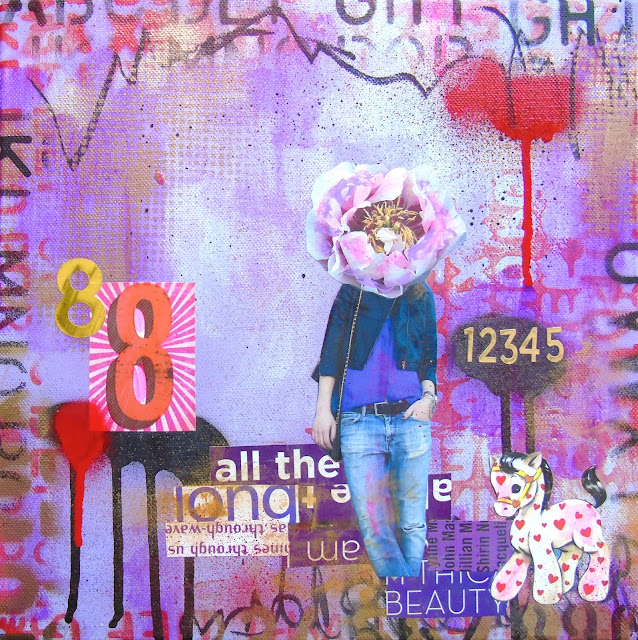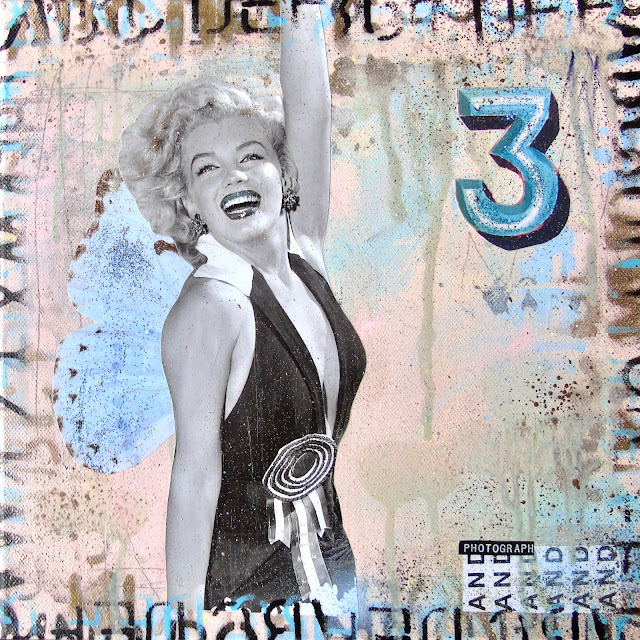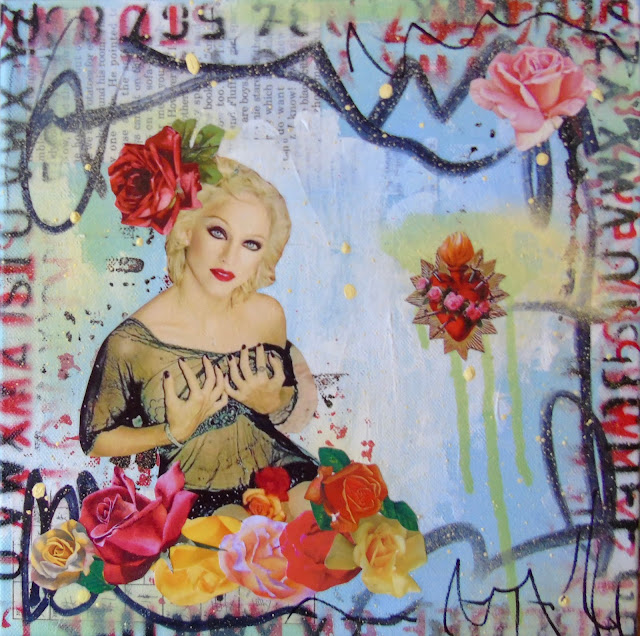Mixed media artist Lorette C. Luzajic
Lorette C. Luzajic is an award-winning mixed media artist from Toronto, Canada. Her signature squares and large collage paintings have been collected in more than 25 countries, including USA, Mexico, Peru, Qatar, South Africa, Estonia, France, Germany, Australia, Austria, Tunisia, Belgium, the Netherlands, Spain, Japan, and Portugal. Her work has appeared in galleries, museums, hotels, banks, nightclubs, corporate and medical offices, as a prop on reality TV, in the Berlin Metro, on a 20 foot billboard in New Orleans, in a magazine ad campaign for Madrid-based diamond company Carrera Y Carrera, and at the Royal Ontario Museum.
Lorette’s artworks are born from eclectic curiosity. She is interested in everything, and takes inspiration from a range of sources, including personal experience, art history, travel, cinema, cities, music, typography, graffiti, advertising, and most of all, poetry and literature. She writes when she is not painting, usually about art.
Why do you use 12x12” squares as your signature?
While there are no limits to the possibilities of collage, cutting directly out of books and magazines means that images are most often relatively small. This lends itself easily to working on smaller substrates. I can cut and paste directly without magnifying images electronically. I collect images and words, in trays and boxes, foraged from pamphlets, brochures, discarded books, newspapers, and magazines, and these are “ready” to glue at my fingertips, so it just makes sense for collage to work small. I like to work on paper, too, and on other small sizes of canvas, but the 12x12” canvas for me is my favourite. It is like an album cover!
The square foot works also lend themselves to a mix and match aesthetic. Grouping similar themes or colour palettes at an exhibition or in a room adds a whole new realm of visual and symbolic potential. A client who chooses several pieces can rearrange them, collage style, to change a room in ways that can’t happen with one larger work.
Finally, there are several benefits from a purely practical standpoint. They are much easier and cheaper to package and ship, and to store. They are easy to take care of and hang. They are affordable to all budgets. For passionate collectors who don’t have any more wall space, there is always room for a square somewhere! For people who live in cities, space is a premium. Many urban apartments don’t have a single large wall space free because it is a window or covered in shelves. A square can be propped inside a bookshelf or on an end table, or hang on a door.
Do you create large works? If yes, how large, and how is the process like?
Yes, I love creating oversize paintings. The canvas must be able to fit in my building elevator, so I usually limit the size to five or six feet long. I love squares, again, and really enjoy 48x48 inches.
The process is very different from my signature squares. The larger works are more abstract and visceral. I work with gesture and energy, and use text and found papers and imagery for aesthetic interest and texture. The viewer will be able to “roam” the artwork to find details and hidden snippets of words and images. Specific symbols or a representational image and juxtaposition is not as important. I do create abstract small squares, but the natural evolution of the process makes the larger ones more likely to be abstract, with fewer recognizable images. The square foot works are often surreal or use a central or main image as the focus point, with the work moving around that. The large works are about energy and emotion, with a labyrinth of layers to unravel.
I have worked on much larger canvases raw. Using unstretched canvas on a roll, just pinning it to the wall and working that way. Rolling it to ship means I don’t have to worry about the crate fitting in the elevator, or the piece taking up a lot of space in my home. I loved the large scale of this, and I love the raw, imperfect look on the paintings, the bubbles and warps of the canvas lend themselves to the energy of my work. I have sold quite a few like this. But I had a hard time getting used to the “feel” of the brush and hands on the canvas and don’t love the way things glue down, the texture of working on a raw cloth rather than a taut one. Doing this affords me the chance to work bigger, but I have more work to do until I’m totally comfortable. Artists all have our preferences for materials- it might be a specific brand of paint they like because of how it flows for them. Some love painting onto wood instead of canvas, because the hard surface works best for them. I will create more this way in the future, I’m sure.
I have found that I don’t much care for working in medium sizes. I do work that way, and enjoy squares that are 24x24” or other mid-range sizes and shapes. But my preference is really twofold: either I sit down with scissors and images and focus in on a small square, or I stand up and work with action and rhythm to music and work on a large canvas.
What do you find so appealing about collage? Who or what have been your inspirations?
I often say that with collage, the whole world is my palette. I am constantly looking around at shapes, patterns, and images, for “gold.” If I see something in real life, I can take a photo and use it in collage. If I see words or phrases, a really important part of my work, I can save them, or cut them out- or I can type them out and print them up.
I use the words “eclectic curiosity” to describe the vibe behind everything that drives me. Collage works for me because I am curious about everything! I love old mechanical drawings and machines; I’m fascinated by different cultures and religions; I love the aesthetic of graphic design; I am really passionate about art history and about poetry. Collage allows all of these things to be mined and meshed together. All I need is a pair of scissors!
I feel like an archeologist, with my little pink scissors. I excavate things from the past and from the world around me, often just a partial shard or clue. I put that thing together, the snippet or tendril, beside something else. I curate things by theme, by appearance, by colour, by shape, by meaning, or by contrast. I shift and move pieces around until it has an emotional or visceral impact on me, and I go from there.
Which awards in collage and mixed media art have you won? What will be your directions in the near future (for example in the next 5 years)?
I won first place in an art promotion by Maple Leaf Sports and Entertainment, with E11even Restaurant, here in Toronto. This was a significant prize of $5000, which went a long way for me towards materials and travel to fuel more inspiration. I was also fortunate to be invited to an international arts symposium in Tunisia. The chance to work with other artists from all over the world, in such an idyllic setting beside the ocean, was epic for me. I worked with luminaries like Dr. Ala Bashir and Ali Rashid, and the great sculptor from Mexico, Carlos Monge. I was the “baby” artist of the group, for sure, and it was an incredible learning experience. I was able to spend a few days in Tunis and in Rome en route as well.
I love to travel and explore other places and cultures, and I am fortunate that interest in my work is international. I hope to have more opportunities to work and exhibit in other places.
What kind of challenges do Canadian painters/artists face right now due to COVID19? Moving forward, how do you think it can be overcome?
The whole world is facing similar challenges. How do we exhibit and show when gatherings are regulated or banned? How do we see our friends and family abroad or travel when we aren’t allowed, or must risk health and safety? How do we work without community? I have tried to be positive about the time spent at home, which I have used to study art history, write, and create more. I’m the kind of person who loves to be alone, and so I did not suffer as much emotionally as people who are highly social. But even so, it is challenging to be separated from your loved ones for so long. I am grateful to be able to see my family, and look forward to normal art opening parties again one day, and to meeting new people.
The economical fallout is terrifying and the second major concern for the world after life and health. It is urgent that those who still have work continue to support organizations and businesses. Don’t shop at Walmart- spend money with smaller businesses- go online and support folks at Etsy or small food providers. Order takeout from local restaurants often and help keep alive the small and diverse players. It will be wretched if we only have the large chains and no interesting businesses left after. All of the small businesses can be accessed and supported online, not just the big chains.
All that said, I think we have all been looking at technology now as a way of connecting like never before. I appreciate the online world but have never used it the way I use it now. I teach collage workshops at the mental health hospital here by Zoom, and I have done poetry readings and panel discussions or lectures in Dubai and Singapore and Vancouver. I’m discovering the fact that, while nothing can replace in person connection, local events are limited by geography, and Zoom meetings allow face to face contact with people all over the world. It has been wonderful to chat with new friends and professional colleagues in other nations and cities. I think we will all do more of that, even after things go back to normal.
More info:
Website: https://www.mixedupmedia.ca
Instagram: https://www.instagram.com/lorette.c.luzajic







